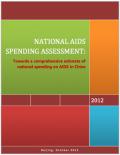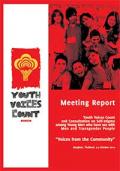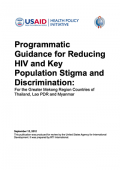What's New
Displaying results 3601 - 3610 of 4914

Resource | Publications,
Comprehensive information about national spending on AIDS response is crucial for health policy development and evaluation. This study provides a comprehensive overview of the overall level and composition of major investments in national AIDS response in Dehong Prefecture introducing National AIDS Spending Assessment (NASA) as a method for the purpose.

Resource | Publications,
This report documents, the presentations and discussions made during the Youth Voices Count 2nd Consultation on Self-stigma Among Young Men who have sex with men and transgender people: Voices from the community, held from 2-5 October 2012 at Bangkok, Thailand.
The primary objective of this regional consultation was to introduce the YVC network and its members and to hear the voices of community people on the self-stigma in young MSM and TG groups in order to develop key recommendations targeting policy-makers and programmers on addressing these issues.

Resource | Presentations,
Regional and country posters were prepared by UNAIDS Regional Support Team Asia-Pacific, UNAIDS Country Offices, and HIV and AIDS Data Hub for Asia-Pacific based on the following published sources of data:
1) HIV Sentinel Surveillance Surveys
2) Behavioural Surveillance Surveys
3) Integrated Bio-behavioural Surveys
4) United Nations General Assembly Special Session on HIV and AIDS (UNGASS) Country Progress Reports 2008 and 2010
5) Global AIDS Response Progress Reports 2012

Resource | Presentations,
Getting to Zero in Asia and the Pacific: Focus and Innovation
UNAIDS Regional Management Meeting October 29, 2012

Resource | Reviews and Snapshots,
The report is intended to provide an evidence-base for: policy makers working in government, regional and multilateral organizations; parliamentarians; members of the judiciary; civil society organizations; donor agencies; and sex workers and their organizations engaged in advocacy to improve the legal and policy enabling environment for HIV responses. The study focuses on 48 countries of the Asia Pacific region, with an emphasis on low and middle-income countries.

Resource | Publications,
The MoH HIV/STI unit conducted active surveillance for select STIs (syphilis, Chlamydia, hepatitis B, and hepatitis C) and HIV rapid testing in 5 districts of Timor-Leste: Covalima, Oecusse, Bobonaro, Dili, and Baucau. The HIV/STI unit also assessed the behavioral characteristics of specific high-risk target groups in those districts: female sex workers (FSW), males who have sex with other males (MSM), and uniformed personnel (UP). These data will help the HIV/STI program quantify HIV/STI prevalence in Timor-Leste and improve its programs.

Resource | Presentations,
Experts Meeting on Methodologies for Obtaining Strategic Information on Young People at Higher Risk of HIV Exposure September 3-5 2012, Bangkok, Thailand

Resource | Guidelines,
Tackling stigma and discrimination for improved HIV prevention and treatment is particularly critical in Greater Mekong Region (GMR) countries of the Lao People’s Democratic Republic (Lao PDR), Myanmar, and Thailand, given that the epidemic is concentrated and growing amongst groups who face not only HIV-related stigma and discrimination, but also the underlying and HIV-associated stigmas of sex work, drug use, gender identity, and same-sex relationships.

Resource | Publications,
The survey was planned, designed and implemented by Punjab Bureau of Statistics. The sample design and listing was provided by Pakistan Bureau of Statistics formerly known as Federal Bureau of Statistics, Pakistan. Technical input was obtained from global desk on MICS4, UNICEF. Fieldwork was carried out from July to December 2011. Findings reveal the significant variations in most of the indicators with respect to location, gender, household characteristics, administrative units and wealth quintiles.

Resource | Fact Sheets,
Men having sex with men (MSM) has continued or emerged to account for a significant proportion of newly acquired HIV infection in countries around the world and also in Hong Kong. The first and second PRiSM was launched in 2006 and 2008 which revealed a HIV prevalence of 4.05% and 4.31% respectively. Organized as a regular public health surveillance programme to track the epidemic and inform intervention, the third round of PRiSM was conducted from July 2011 to February 2012.





